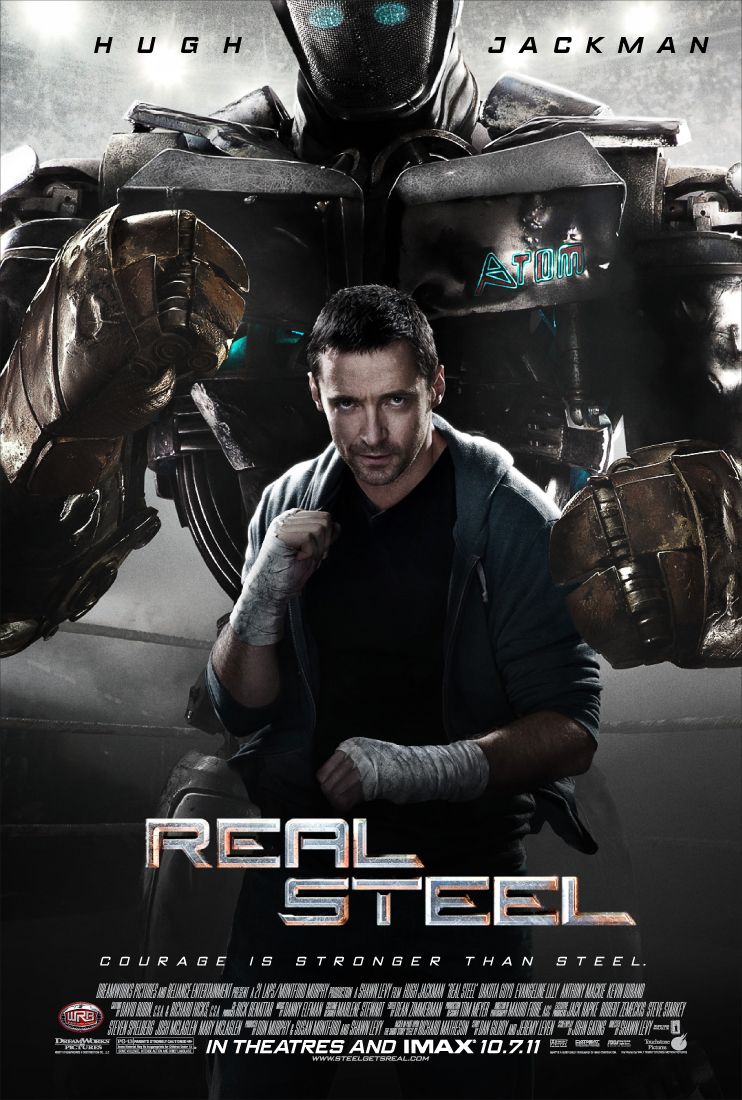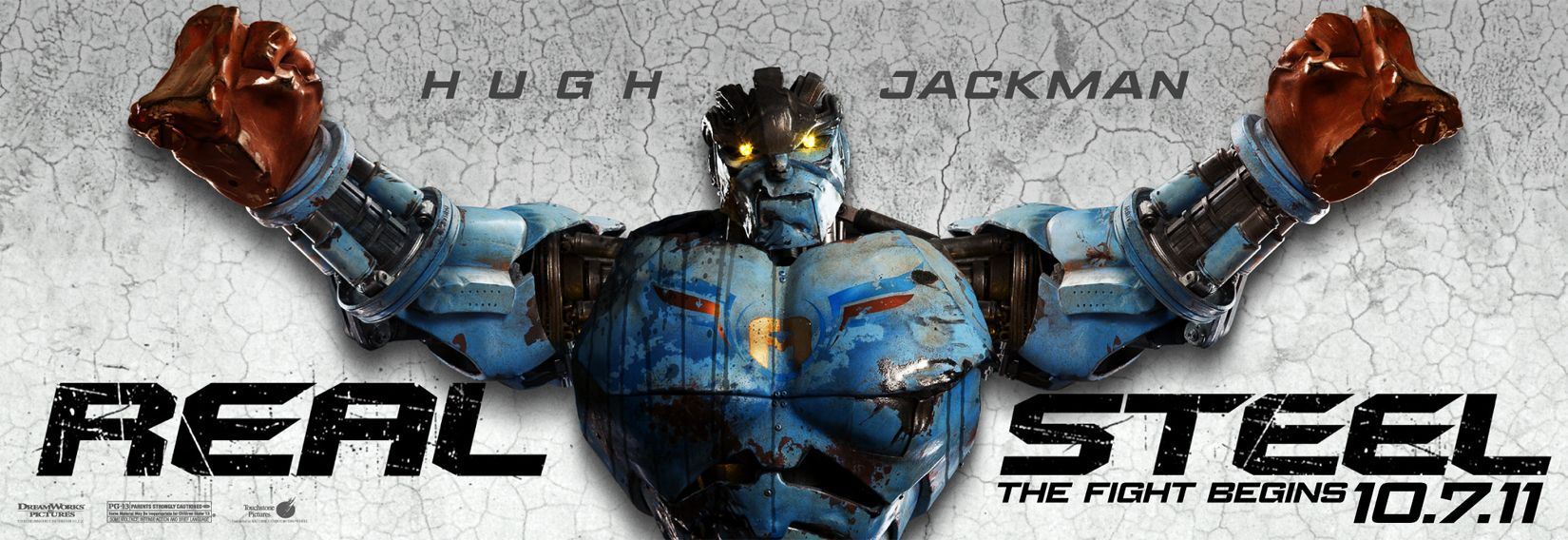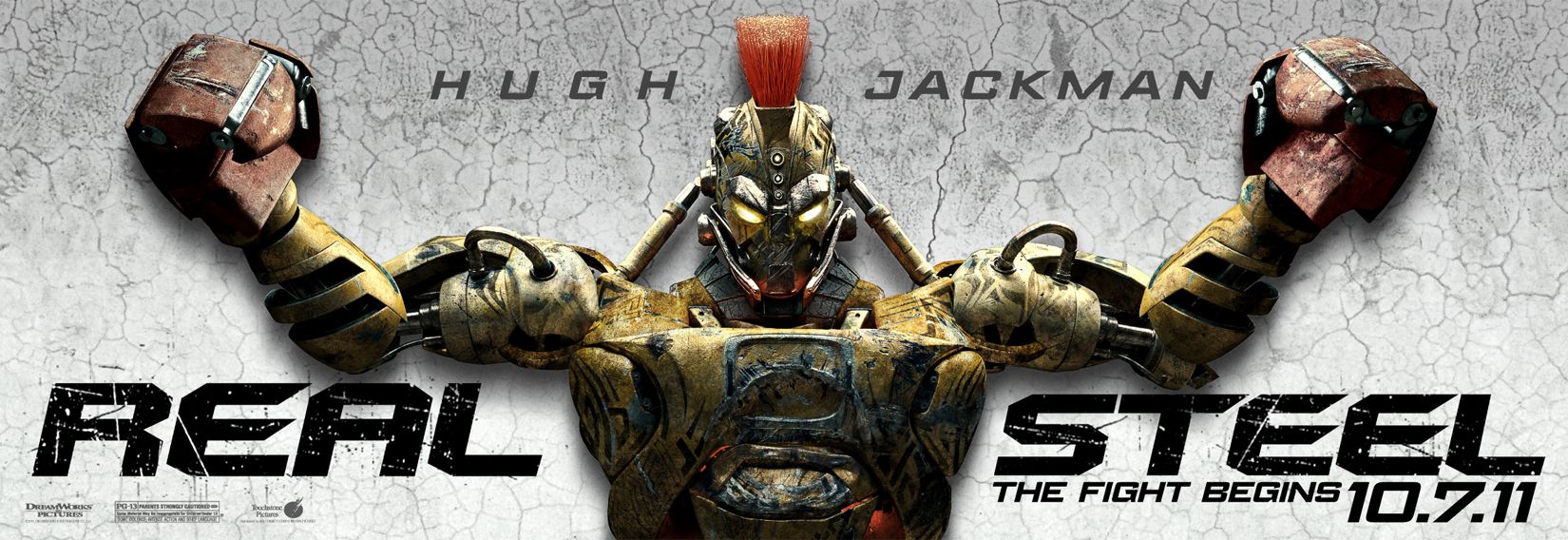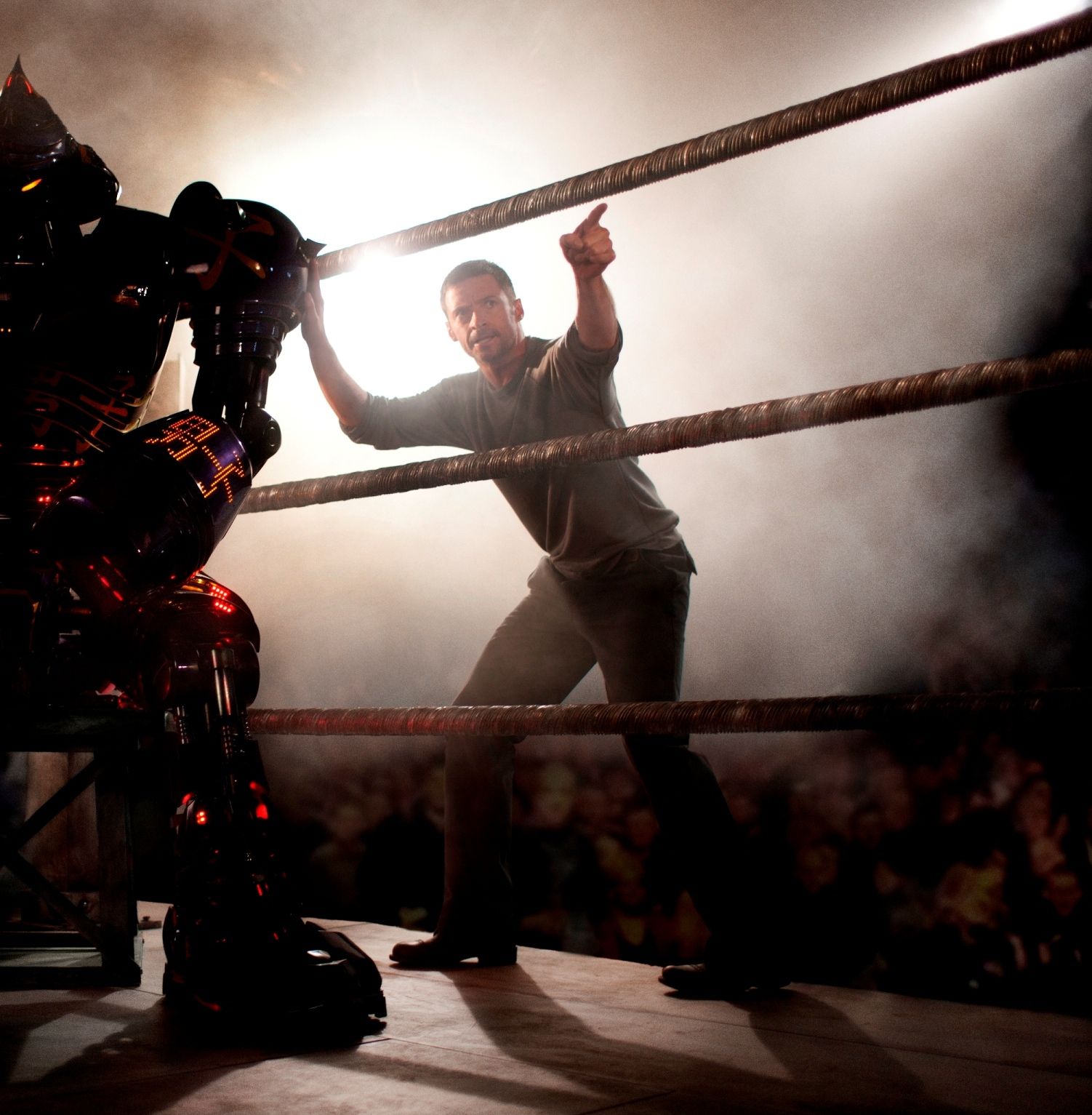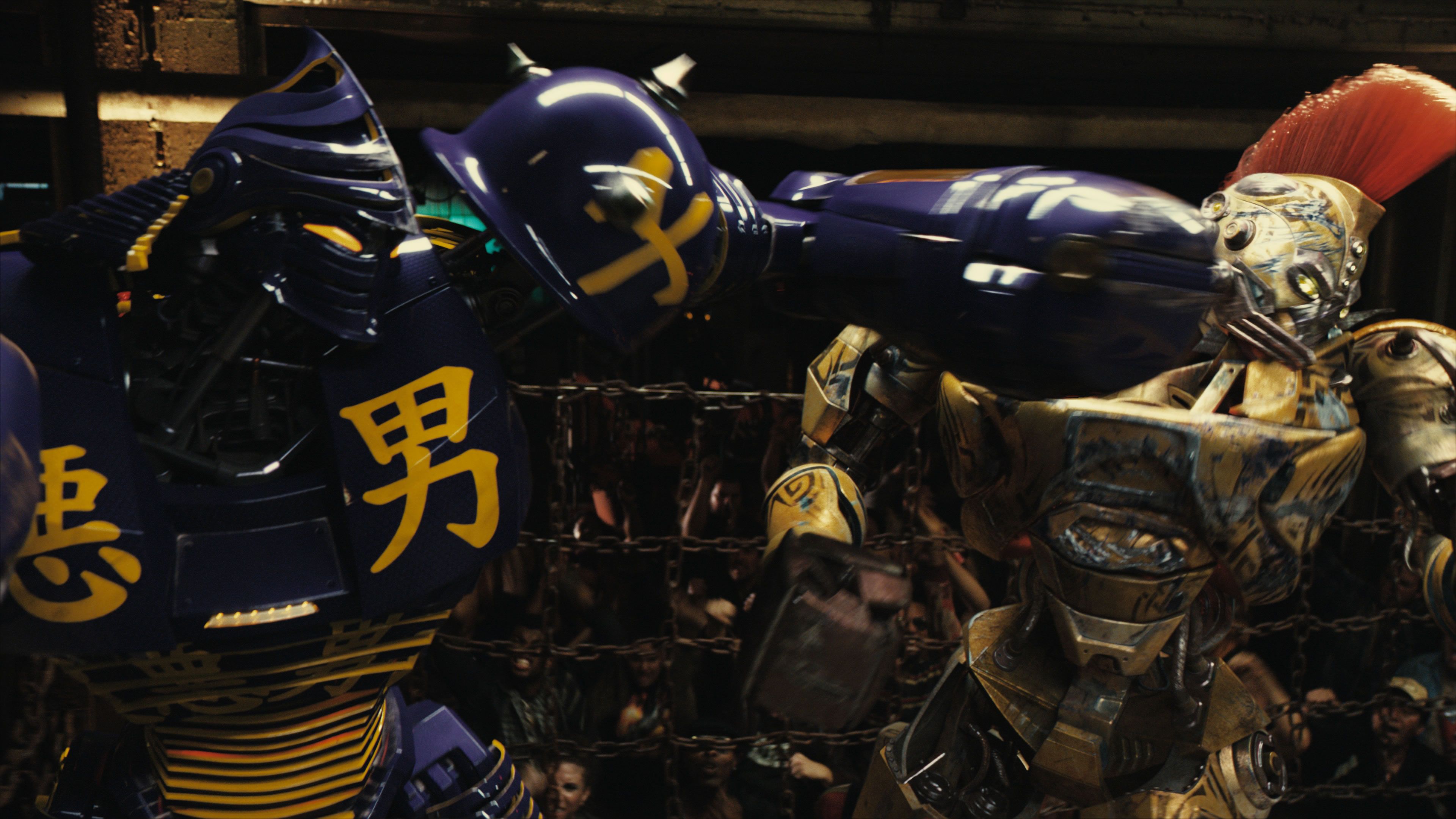For those unfamiliar with Real Steel, lets break down the story. First of all, yes, the Rock 'Em Sock 'Em Robots comparison is rather valid, although these robots are, you know, much bigger. The movie, which is based on a short story by I Am Legend author Richard Matheson, is set in the year 2020, where all forms of human combat sports (boxing, mixed martial arts, professional wrestling, Jersey Shore...) have been outlawed and replaced with robot boxing. Instead of watching two humans duke it out, the nation is transfixed on the World Robot Boxing league, WRB for short, where 10-foot robots, controlled by humans at ringside, battle it out in a huge retro-fitted ring. The story centers on Charlie Kenton (Hugh Jackman), an ex-boxer who finds a discarded old robot and rebuilds him with hopes of making it to the promised land of the WRB. While the WRB is the top dog in this sport, there are several underground robot boxing elements as well, which Charlie utilizes to reach the WRB. Along with this new endeavor, Charlie is also faced with the challenge of discovering he has an 11-year-old son (Dakota Goyo), who he must now take care of, and who helps him rebuild the robot.
I probably shouldn't tell you a whole lot about the scene we watched them shoot, which involved Hugh Jackman and Dakota Goyo, because it is literally the last scene of the movie. I will say, though, that the WRB ring looks very cool under all the lights, and that I was very impressed by the actual physical robots they had on the set. It is also worth noting that Charlie's robot has a "shadow" operating system, which means that the robot mimics the actions of its controller. Naturally, since Charlie is a former boxer, this provides somewhat of an advantage, even though this "shadow" OS is considered to be antiquated in the WRB, with most of the robots being controlled by sophisticated remote controls. To add even more authenticity, the robot fight scenes were choreographed by none other than boxing legend Sugar Ray Leonard. While there were gigantic practical robots on the set, the fight sequences were actually performed by actors in motion-capture suits, and integrated into the CGI robots with a new technology called SimulCam B, an innovative technology which we'll discuss later in this piece.
Shortly after we arrived on the set, we were greeted by director Shawn Levy and star Hugh Jackman, who sat down with us in the Cobo Hall stands to answer our questions. Here's what they both had to say below.
Some of the films that both of you have made have been fairly large. What is the scope of this movie?
Shawn Levy: This is the biggest movie I've ever made. I've done a few, as has Hugh, which are hardly small films. I think it's safe to say that this parallels or exceeds the scale of those. What our goal was, we've both done huge spectacle movies, and this is definitely that, but the whole premise of me considering this movie when (executive producer) Steven Spielberg called me up and asked if I would consider this movie, which is how it all started, I said, 'Yes, but I don't want to do just another robot fetish movie.' Frankly, Michael Bay has done it well, James Cameron has done it well. Doing a robot movie in 2011, is never going to be inherently fresh. What is fresh is to do a movie about machines, a movie that has robots in it that is unabashedly humanistic and emotional. For us, that's the big difference for this movie. It's the visual scale that we've done before, and it's certainly the most emotional drama I've ever done. You'll get a hint of it in what we're going to show you, but the goal was for it to be crazy bad-ass and really moving.
Can you talk about the things that inspired you visually and tonally for this?
Shawn Levy: Certainly, if you do a boxing movie, there are antecedents for anyone who loves movies. For me that meant rewatching Raging Bull, rewatching all the Rocky movies, The Champ, Paper Moon. There's a big E.T. component in here, because it's about a boy whose personal life is broken and makes a personal connection with another, and it's a redemptive connection. Steven and I have still never talked about it, but it's there in the blood of the story. As far as models for this, we talked about Paper Moon, which was a father-daughter road movie, where the father and daughter didn't particularly like each other or want to be with each other. This movie has a similar dynamic. Searching for Bobby Fischer is another one, that's in my top 10. There was something really lyrical in that. It was a drama, but it there was also something very magical and beautiful in that. That was a big paradigm for me, because if I'm going to do my first non-comedy, I wanted it to be a radical departure from what I have done. A huge component of that is, even though I've worked with some great DP's, I specifically wanted a break from the past, visually. (Director of Photography) Mauro Fiore was an incredible match. He has the tech-savvy of having done Avatar, but it's Training Day that got him this job. Training Day was a beautifully, unvarnished, color-saturated, rough-looking movie that was also beautiful. This movie, we wanted it to be rough and beautiful.
Hugh Jackman: My character, Charlie, abandoned his son at birth, and is reunited with him when he's 10. Not by choice, but by law because his mother dies. What I presume are guys coming to get money that I owe them, and I actually get in a fight with one of the guys, they turn out to be these guys coming from the courts, coming to tell me that I'm the only next of kin. He's pretty much at a low point at his life, and, I won't give away all the details, but they're kind of forced together. Neither of them want to be with each other, and, as Shawn said about the kid, the same with Charlie. They're two damaged souls and, by luck, they find this junkyard robot, literally in the garbage dump.
Shawn Levy: The script was solid, but once I came on, I spent seven months rewriting the script. The whole premise is, and forgive me because I'm plagiarizing myself, but really the idea is that the boy, the father, and the machine, are cast off, they're forgotten. They're on the margins of society and they find this robot literally buried in the earth. They're really this trinity of forgotten beings who, for having met each other, come back to life.
Hugh Jackman: Yeah. For all of them, it's a second chance. Charlie was a boxer, but now boxing is irrelevant and he's sort of eking out a living in robot boxing. He's an owner/promoter, he's really in the underworld. What you're seeing is the World Robot Boxing league. It's the biggest sport in the world. For all of them, for their relationship as father and son, and this Generation 2 robot, which is like three generations ago, found in the junkyard, it's a second chance for all of them. We all love the story of somebody getting another shot.
Shawn Levy: It's been a long time that I can think about a real, genuine, sports movie. The movie is way more in the sports movie paradigm than in the science-fiction paradigm. The idea was that the world looks real. It's 2020. The world is recognizably linked to the world we're sitting in right now, but this one sport has evolved. Here's what we know as fact. With the rise of UFC and mixed martial arts, and the fall of conventional boxing, the thirst for spectacle, for carnage, we're already seeing the effect of that. The rules have gotten more lax, the things you can do in the ring have increased, so where this movie kind of goes, and its based largely on this Richard Matheson short story and this Twilight Zone episode, it's about people's desire for spectacle. The frailty of the human body has given rise to this sport. They're machines, so we pay money to see them completely wail on each other.
Shawn Levy: The Richard Matheson short story, and the adaptation of that story which he actually wrote for The Twilight Zone, it's an episode called Steel, starring Lee Marvin. There is a sport of robot boxing and it's about a robot boxing promoter, who is so desperate for a gig, he'll do anything for a payday. Hugh's character is a promoter, but we went with the decision that Hugh is a former boxer, who now has to make a living off of the things which put him out of a job. There's this resentful positioning of him towards the things he makes his living on. The father-son story is completely not in the Richard Matheson short story, and it became the heart of the movie. The connection between the boy and Hugh and the boy and the robot, that really becomes the emotional heart of our movie, and that's all of our own invention.
Do the robots have their own personalities?
Shawn Levy: Here's what I would say. We designed 20 robots, and they all have individual aesthetics. They don't talk. They don't express feelings. They're controlled by humans. They do not walk around in the streets. This is not A.I.. They are not servants or butlers, it's not a mechanized society in that way. It's this sport which as evolved. They are controlled by a number of people in their boxing corners. Where the movie hopefully gets some of its magic, it's that this robot, Atom, who is obsolete compared to most robots in the movie, there's something about this robot that the kid believes there is something in there. The robot doesn't talk, doesn't move, doesn't express anything, but when you meet him and you see his face, you'll understand. There's something in the design of this bot that it may have something that resembles a soul.
How much does it get into where boxing and the other sports fell off and this sport evolves? Does the beginning of the movie get into that aspect?
Shawn Levy: We don't start with a prologue of that sort, but what we do is, in the first scene, we learn that Hugh was a boxer, and we learn what kind of boxer he was. He wasn't the champ, no offense to Hugh.
Hugh Jackman: He was 24 and 19.
Shawn Levy: Yeah, 24 and 19, but, as Evangeline Lilly says in the movie, '24 and 19, but every fight a knockout.' With this guy, a fight wasn't over until someone was on the mat. That's how he fought, to which he replied, 'Yeah, it was usually me.' So, the guy has no illusions about what he is. He's a scrapper. He's going to keep swinging until he can swing no more.
Hugh Jackman: The boy is 10, and he doesn't really know the world of boxing. He's interested that his dad was a boxer and he wants to know more about it, but I don't really want to tell him all that stuff. You do hear about it, but we start in a world where it's already gone.
Hugh Jackman: Another point about the robots, yes they're robots, but they're given personality in their aesthetic, they're given personality by their owners, their handlers, in how they fight with them. We understand that it's all about show and the greatest fighters, as my character explains, they understood the entertainment of it all. It's all about the show.
Shawn Levy: Some of our bots are dirty fighters. They'll use elbows, knees, chokes, kidney punches, anything. There are two tiers in the movie, the underworld and the league. The WRB is the World Robot Boxing. It is the bigs. It's the NBA, NASCAR, corporate sponsors, big money. That isn't the world Hugh lives in, which is county fairs, old abandoned car factories, the post-industrial American landscape. There are no rules, it's just fight until one robot is done moving. So, the journey of the movie, is getting that shot out of the underworld.
After that conversation, we were lead into an office where we were shown a slick little sizzle reel, which was rather cool. We saw several of these robot characters, and were given a glimpse of this underworld, with a scene where Hugh Jackman is trying to book a fight with Anthony Mackie, another underground promoter. He's trying to get his robot, Atom, to fight one of the top robots, Midas. We also get a glimpse at how savvy Dakota Goyo's character is, because he thinks Atom should just fight in an undercarded bout, while Hugh Jackman is shooting for the main event.
Just from watching these few scenes, I could tell immediately that Shawn Levy wasn't being untruthful when he said this would be the biggest movie he has ever made. We don't see the actual fight, but we did get a wonderful sense of this industrial robot boxing underworld and the size and scope of these robots. After the reel, we were able to fire some more questions at Shawn Levy to take us deeper inside this world.
Can you talk a bit more about Atom's shadow technology? Is that not a common thing with other WRB robots?
Shawn Levy: No, in fact, it's a story point. Atom is a Generation 2 sparring robot. He was built in the early days of the sport as a sparring tool for league robots. So, lets say I own Gamma, who was the first WRB champ. When they wanted to get Gamma ready for a fight, they would use shadow mode and they would program the combinations and fight styles of Gamma's opponent, into Atom, using shadow mode. It's rare, it's not done a great deal in the current WRB, and, only because Atom is slightly archaic, does he have the shadow mode.
What mode do the current robots operate under?
Shawn Levy: They're programmed mechanically, by and large. It's not with a human standing in front of them, showing them what to do. It's with joysticks and a command center, that operates their servos, their hydraulics, their mechanisms, and its stored into a computer chip that links their operating system, locally, with an operating system of whoever is operating it. Frankly, people don't value human boxing style, in the world of the movie, which is what makes Hugh's character obsolete, and, maybe, useful.
In the league, who is the celebrity? The robot or the controller?
Shawn Levy: The celebrities in the league are two-fold. The people who own Zeus, who is the league champ, is Faryl Limkova, the daughter of a Russian oligarch dynasty. So, basically, dad's a billionaire, she's magnificent looking, and, basically, they wanted to build the first super-bot, a bot who couldn't be defeated. The Limkova's went to Tak Mashido. He is the god of this WRB. Tak Mashido, when he was 22, was this wunderkind out of Japan who designed an early league robot called Noisy Boy, with the shogun-inspired helmet. He designed both the aesthetics of the robot, and the programming. He's a crazy genius. He retired, went into seclusion, and shortly before the movie starts, the Limkova's brought Tak Mashido out of retirement and they basically said you have an open checkbook, build us a bot that can't lose, and he designed Zeus. So, the celebs of this movie, are Tak Mashido and Faryl Limkova.
What's your focus on the sub-text of having technology, spectacle, and where our society is heading as avatars?
Shawn Levy: I've watched the shift from boxing to crazy rise of MMA, so that's one notion. I remember when my second Museum movie came out, I was driving around and I noticed that the entire ad campaign for Transformers: Revenge of the Fallen, they literally were skipping the humans. They literally didn't give a shit about humans anymore. There was Bumblebee, there was Optimus, it was an entire campaign of robots. Similarly, the same weekend my movie opened, Terminator Salvation opened, and there was that crazy, skeletal T-9000, or whatever that was. I was just looking around and seeing that, in combination with Robot Wars and even some of the stuff coming out of Japan on YouTube with robot dance displays, I was just thinking about this increased fetishization of machines and robots. My first observation was completely selfish, because I had a movie coming into the marketplace and everywhere else I looked had posters of robots. It was interesting how they were selling entertainment, and that's the premise of this movie, the dehumanization of entertainment.
Was Detroit chose because there is sort of that underdog tie-in with the city?
We then were shown another clip where we see an actual robot boxing fight, with Noisy Boy squaring off against Midas, in that same underground facility from before. Noisy Boy was a premiere WRB robot in the early days of the sport, but, as Shawn Levy explained, once he started losing, he drifted down into the underworld, fighting non-sanctioned bouts. While the clip was pretty cool, what we were shown after was rather revolutionary. He showed us this wonderful filmmaking tool dubbed SimulCam B, which was used, in a sense, on Avatar. For the fight scenes, they captured real boxers in motion-capture suits fighting, and they can then insert the robot avatars set to the motion-capture work, all on the set. So, basically, instead of watching two guys in funny suits fight, he can see both that, and, on another monitor, what those actual moves will look like with the CGI robot counterpart. Shawn Levy told us that SimulCam B was invented for Avatar, but it was used in a different way. It was used so they could see virtual creatures in the digital world of Pandora while they were filming live-action elements, and Real Steel uses it so they can see digital creations in a real-world environment, on the set, as it's happening. It's really quite phenomenal and it allows the director to fully see everything in camera, on the set, instead of waiting until post-production to see how everything matches up.
After that demonstration, we went back to the set and actually saw this SimulCam B technology in action, as they were filming. Instead of seeing two mo-cap actors in the ring fighting, we can see two robots slugging it out, as if they were actually there with us. This revolutionary tool will certainly be used more in the future, and I can't wait to see how it helps shape future tentpole projects like this one.
That about wraps up Part 1 of my Real Steel set visit. Stay tuned for Part 2 where we speak with Hugh Jackman on his own, plus production designer Tom Meyer and Jason Matthews from the Legacy visual effects studio.


